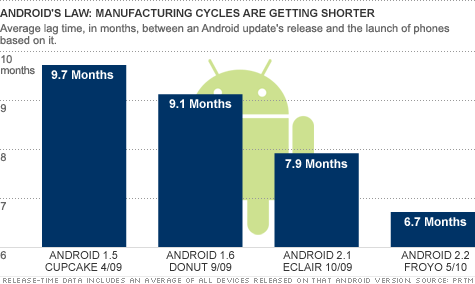By David Goldman,
NEW YORK (CNNMoney) -- If you bought a smartphone within the past year, you might already have noticed that your once-cool superdevice is feeling outdated.
There's a reason for that: "Android's law."
Smartphones are continually outdueling one another in terms of performance, and they're coming to market at a breakneck speed.
For instance, if you picked up the Motorola (MMI) Droid when it went on sale in November 2009, you had the best Android device on the market. But then the twice-as-fast Nexus One went on sale in January 2010. Then the HTC Droid Incredible hit the market in April. Then in June, the Evo 4G put the Droid Incredible to shame. The Samsung Galaxy S came out later that month. Then the Nexus S ... You get the point.
The average time smartphones spend on the market is now just six to nine months, according to HTC. But it wasn't always this way: Average shelf time was about three years prior to 2007, HTC estimates.
"Now consumers want more power and faster phones," said Keith Novak, spokesman for HTC. "With increased competition, there's a more pressing reason for shorter lifecycles."
Before Apple (AAPL, Fortune 500) debuted the iPhone, the hottest selling handset on the market was the Motorola RAZR, which held that position for five years. Five years! Could you imagine anyone buying an original iPhone today -- a phone that debuted less than four years ago? That hunk of junk didn't even have 3G. Or apps.
The pace of smartphone innovation has ramped up to ludicrous speed and mobile competition has gone cutthroat thanks to two key factors: The rise of Google's Android operating system and the predominance of Qualcomm processors.
The way it was: Just a few years ago, mobile phone makers had to design their devices through and through: The hardware, operating system, chipset and design were all made by LG, HTC, Samsung, Motorola, and their rivals.
All that time and effort meant phones took a long time to get to market, and they needed to stay there for years to make back all the investment that went into designing the device.
The way it is now: But then along came Android, an open source, free-to-license OS. The availability of Android means device manufacturers can just load the ready-made software onto their phones instead of paying a team of engineers to develop a proprietary OS. And they can customize it as much as they like.
"The beauty of Android is that it's completely open," said Marcelo Claure, founder and CEO of Brightstar Corp, a global service provider in the wireless industry. "All the equipment manufacturer has to do is slap a skin on top of it and market the phone."
It's not just the software that's prepackaged: Smartphone chipsets are coming ready-made as well.
Seeing the opportunity created by Android, Qualcomm (QCOM, Fortune 500) quickly jumped on board and began to make smartphone chips that are specifically optimized for Google's (GOOG, Fortune 500) OS and apps. Instead of designing their own chips, manufacturers like LG, Motorola and HTC now simply use Qualcomm's.
"What we deliver to the manufacturer allows them to spend their resources in a different way, instead of reinventing the plumbing of each phone," said Jason Bremner, product manager of Qualcomm's CDMA Technologies.
The Qualcomm/Android ("Quadroid") standard that has developed over the past couple of years has freed up smartphone manufacturers to focus most of their attention on marketing and making their devices thinner, sleeker and higher-functioning than competitors'.
As a result, smartphone manufacturing cycles have doubled in speed in the past two years to just over four months, according to industry consultancy PRTM.
That means device makers can churn out smartphones at an incredibly rapid pace, taking the handsets from concept to store shelves in a relative blink of an eye.
Android's law: We're calling this new trend "Android's law." It's similar to Moore's law, the 1965 paper by Intel (INTC, Fortune 500) co-founder Gordon Moore, which observed a trend that has held true for more than five decades: Microchip manufacturers can double the number of components on a piece of silicon every two years.
Though we're not making any technical predictions, the introduction of the Quadroid standard has turned the wireless market on its head -- and this new trend is likely to continue for years to come.
Android's law has allowed new, previously unknown competitors like ZTE to double its market share and become the fourth-largest mobile phone vendor in the world. It has led to the quadrupling of phone processor speeds over the past year. And it's helped Google's mobile operating system go from zero to 300,000 activations a day on more than 100 phones in just 26 months.
"We're seeing hundreds of new models -- it's crazy," said Will Stofega, analyst at IDC. "Since Android is free, these manufacturers are willing to take some chances. The need to come up with something that's going to stick and be a major player is intense."
Analysts agree that the market cycle at some point will stop shortening because customers can't absorb new products so fast.
But one lasting change is clear: It's not going back to the way it was.
"This will keep going until phones become just thin slabs with a touch screen," said Soumen Ganguly, principal at Altman Vilandrie. "It will be just like the development of the PC industry -- everyone will keep trying to outdo one another to stay alive."

No comments:
Post a Comment